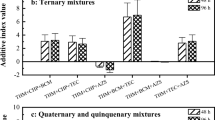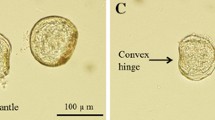Abstract
Aquatic ecosystems are vulnerable to the exposure with petrochemicals such as toluene, ethylbenzene, and xylene (o-, m-, and p-xylene) (TEX) and their adverse effects. Considering the widespread use, occurrence, and high toxicity of TEX, the aim of this work was to investigate the differential toxicity of TEX against midge (Chironomus plumosus) larvae and reveal the joint action of binary and ternary mixtures of TEX using the predictive concentration addition model. More importantly, this research can afford the basic toxicity data and scientific reference for the establishment of water quality criteria or benchmark, water pollution control, and aquatic risk assessment. Single and joint toxic effects of TEX on C. plumosus larvae were investigated using a semi-static bioassay, and the type of joint effects of TEX was ascertained. In the single toxicant experiments, the toxicity of the three pollutants could be sequenced as ethylbenzene > xylene > toluene. Specifically, LC50s of T, E, and X after a 48-h exposure were 64.9, 37.8, and 42.0 mg/L, respectively. In the binary mixture experiments, the interaction between toluene and ethylbenzene, ethylbenzene and xylene, and toluene and xylene was largely in conformity with partial additive or additive effect as determined by isobologram representation and toxic unit models. In the ternary mixture experiments, the interaction was basically dependent on the use of additive index and mixture toxicity index methods. However, the antagonistic and synergistic actions were not significant. Thus, the tertiary mixture interaction could be regarded as additive action. The concentration addition model could successfully predict the joint action of TEX mixtures on C. plumosus larvae. Particularly, the additive action of TEX on C. plumosus larvae can be further recommended to evaluate water quality criteria of TEX.


Similar content being viewed by others
References
Altenburger R, Boedeker W, Faust M, Grimme LH (1990) Evaluation of the isobologram method for the assessment of mixtures of chemicals. Combination effect studies with pesticides in algal biotests. Ecotoxicol Environ Saf 20:98–114
Altenburger R, Backhaus T, Boedeker W, Faust M, Scholze M, Grimme LH (2000) Predictability of the toxicity of multiple chemical mixtures to Vibrio fischeri: mixtures composed of similarly acting chemicals. Environ Toxicol Chem 19:2341–2347
Applegate BM, Kehrmeyer SR, Sayler GS (1998) A chromosomally based tod-luxCDABE whole-cell reporter for benzene, toluene, ethylbenzene, and xylene (BTEX) sensing. Appl Environ Microbiol 64:2730–2735
Armitage PD, Cranston PS, Pinder LCV (1995) The chironomidae: biology and ecology of non-biting midges. Chapman & Hall, London
ATSDR (2001) Guidance manual for the assessment of joint toxic action of chemical mixtures. Final/Technical Report. U.S. Department of Health and Human Services, Public Health Service Agency for Toxic Substance and Disease Registry, Atlanta, GA, USA
Berenbaum MC (1985) The expected effect of a combination of agents: the general solution. J Theor Biol 114:413–431
Berenbaum MC (1989) What is synergy. Pharmacol Rev 41:93–141
Boedeker W, Altenburger R, Faust M, Grimme LH (1992) Synopsis of concepts and models for the quantitative analysis of combination effects: from biometrics to ecotoxicology. ACES 4(3):45–53
Broderius SJ, Kahl M, Hoglund MD (1995) Use of joint toxic response to define the primary mode of action for diverse industrial organic chemicals. Environ Toxicol Chem 14(9):1591–1605
Calamari D, Vighi M (1992) A proposal to define quality objectives for aquatic life for mixtures of chemical substances. Chemosphere 25:531–542
Cedergreen N, Christensen AM, Kamper A, Kudsk P, Mathiassen SK, Streibig JC, Sorensen H (2008) A review of independent action compared to concentration addition as reference models for mixtures of compounds with different molecular target sites. Environ Toxicol Chem 27:1621–1632
Duan Z, Zhu L, Zhu L, Kun Y, Zhu X (2008) Individual and joint toxic effects of pentachlorophenol and bisphenol A on the development of zebrafish (Danio rerio) embryo. Ecotoxicol Environ Saf 71(3):774–780
Dudek B, Gralewicz K, Jakuboski M, Kostrzewski P, Sokal J (1990) Neurobehavioral effects of experimental exposure to toluene, xylene and their mixture. Pol J Occup Med 3:109–116
Elisabet A, Ernest MU, Gloria C, María EA, Inmaculada GR, Francisco G (2010) Advanced oxidation of benzene, toluene, ethylbenzene and xylene isomers (BTEX) by Trametes versicolor. J Hazard Mater 181:181–186
Fan YW, Zhou QX (2008) Research advances on environmental behavior and toxicity of BTEX. Chin J Ecol 27:632–638, in Chinese
Fan YW, Zhou QX (2009) Toxic effects of toluene, ethylbenzene and xylene in waters on zebrafish Brachydanio rerio. Asian J Ecotoxicol 4:136–141, in Chinese
Fan YW, Zhou QX, Wang YY, Zhu S (2009) Toxic effects of BTEX in water on Daphnia magna and Limnodrilus hoffmeisteri and safety assessment of the aquatic environment. J Environ Sci 29:1485–1490, in Chinese
Faust M, Altenburger R, Backhaus T, Blanck H, Boedeker W, Gramatica P (2003) Joint algal toxicity of 16 dissimilarly acting chemicals is predictable by the concept of independent action. Aquat Toxicol 63:43–63
Frantik E, Vodickova L (1995) Combined effects of binary solvent mixtures. Cent Eur J Occup Environ Med 1:31–37
Gessner PK (1995) Isobolographic analysis of interactions: an update on applications and utility. Toxicol 105:161–179
Hadjispyrou S, Kungolos A, Anagnostopoulos A (2001) Toxicity, bioaccumulation, and interactive effects of organotin, cadmium, and chromium on Artemia franciscana. Ecotoxicol Environ Saf 49:179–186
Holcomebe GW, Phipps GL, Sulaiman AH, Hoffman AD (1987) Simultaneous multiple species testing: acute toxicity of 13 chemicals to 12 diverse freshwater amphibian, fish, and invertebrate families. Arch Environ Contam Toxicol 16:697–710
Huang MY, Jin C, Liu YT, Qu QS, Uchida Y, Inoue O, Nakatsuka H, Watanabe T, Ikeda M (1994) Exposure of workers to a mixture of toluene and xylenes. I. Metabolism. Occup Environ Med 51:42–46
Ikeda M (1988) Multiple exposure to chemicals. Regul Toxicol Pharmacol 8(4):414–421
Jonker MJ, Piskiewicz AM, Castella NII, Kammenga JE (2004) Toxicity of binary mixtures of cadmium–copper and carbendazim–copper to the nematode Caenorhabditis elegans. Environ Toxicol Chem 23:1529–1537
Junghans M, Backhaus T, Faust M, Scholze M, Grimme LH (2006) Application and validation of approaches for the predictive hazard assessment of realistic pesticide mixtures. Aquat Toxicol 76:93–110
Kastner JR, Domingo JS, Denham WP, Brennan MJ, Principe JM, Spivack JL (1998) Biodegradation of TCE and dichloro-methane in contaminated soil and groundwater. Biorem J 2:29–42
Könemann H (1981) Fish toxicity tests with mixtures of more than two chemicals: a proposal for a quantitative approach and experimental results. Toxicol 19:229–238
Kortenkamp A, Altenburger R (1998) Synergisms with mixtures of xenoestrogens: a reevaluation using the method of isoboles. Sci Total Environ 221:59–73
Koutsaftis A, Aoyama I (2007) Toxicity of four biocides and their mixtures on the brine shrimp Artemai salina. Sci Total Environ 387:166–174
Lange JH, Thomulka KW (1997) Use of the Vibrio harveyi toxicity test for evaluating mixture interactions of nitrobenzene and dinitrobenzene. Ecotoxicol Environ Saf 38:2–12
Lazaroaie MM (2010) Multiple responses of gram-positive and gram-negative bacteria to mixture of hydrocarbons. Braz J Microbiol 41(3):649–667
Li L, Goel R (2012) Biodegradation of naphthalene, benzene, toluene, ethyl benzene, and xylene in batch and membrane bioreactors. Environ Eng Sci 29(1):42–51
Marking LL (1977) An approach for additive toxicity of chemical mixtures. In: Mayer FL, Hamelink JL (eds) Aquatic toxicology and hazard evaluation. ASTMSTP634. American Society for Testing and Materials, Philadelphia
Marking LL, Dawson VK (1977) Method of accessing additive toxicity of chemical mixtures: aquatic toxicicology and hazard evaluation. ASTMSTP Publ 634:99–108
Masten LW, Boeri RL, Walker JD (2002) Strategies employed to determine the acute aquatic toxicity of ethylbenzene, a highly volatile, poorly water-soluble chemical. Ecotoxicol Environ Saf 27:335–348
MEPPR (2002a) Environmental quality standard for surface water. GB 3838–2202. Ministry of Environmental Protection of the People’s Republic of China, Beijing
MEPPR (2002b) Integrated wastewater discharge standard. GB 8978–1996. Ministry of Environmental Protection of the People’s Republic of China, Beijing
Niederlehner BR, John CJ, Eric PS (1997) Modeling acute and chronic toxicity of nonpolar narcotic chemicals and mixtures to Ceriodaphnia dubia. Ecotoxicol Environ Saf 39:136–146
OECD (2006) Guidelines for the testing of chemicals. Organization for Economic Co-Operation and Development, Paris
Office of Underground Storage Tank (1990) LUST trust fund monthly progress report. U.S. Environmental Protection Agency, Washington
Otitoloju AA (2002) Evaluation of the joint-action toxicity of binary mixtures of heavy metals against the mangrove periwinkle Tympanotonus fuscatus var radula (L.). Ecotoxicol Environ Saf 53:404–415
Otson R, Williams DT, Bothwell PD (1982) Volatile organic compounds in water at thirty Canadian potable water treatment facilities. J Assoc Off Anal Chem 65(6):1370
Peterson DR (1994) Calculating the aquatic toxicity of hydrocarbon mixtures. Chemosphere 29:2493–2506
Phelps CD, Young LY (1998) Anaerobic biodegradation of BTEX and gasoline in various aquatic sediments. Biodegradation 10:15–25
Smyth HF, Weil CS, West JS, Carpenter CP (1969) An exploration of joint toxic action: twenty-seven industrial chemicals intubated in rats in all possible pairs. Toxicol Appl Pharmacol 14(2):340–347
Spurgeon DJ, Jones O, Dorne JL, Svendsen C, Swain S, Sturzenbaum SR (2009) System toxicology approaches for understanding the joint effects of environmental chemical mixtures. Sci Total Environ 408:3725–3734
Stephan CE, Mount DI, Hansen DJ, Gentile JH, Chapman GA, Brungs WA (1985) Guidelines for deriving numerical national water quality criteria for the protection of aquatic organisms and their uses. USEPA Office of Research and Development, Washington
Sun XB, Cui FY, Guo ZH (2007) Toxicity and influencing factors of chlorine dioxide to chironomid larvae. Environ Sci 28(11):2569–2573, in Chinese
Tardif R, Laparé S, Charest-Tardif G, Brodeur J, Krishnan K (1995) Physiologically-based pharmacokinetic modeling of a mixture of toluene and xylene in humans. Risk Anal 15(3):335–342
Tardif R, Charest TG, Brodeur J (1996) Comparison of the influence of binary mixtures versus a ternary mixture of inhaled aromatic hydrocarbons on their blood kinetics in the rat. Arch Toxicol 70:405–413
Tardif R, Charest-Tardif G, Brodeur J, Krishnan K (1997) Physiologically based pharmacokinetic modeling of a ternary mixture of alkyl benzenes in rats and humans. Toxicol Appl Pharmacol 144:120–134
USEPA Office of Research and Development (2001) Draft final guidelines for carcinogen risk assessment. U.S. Environmental Protection Agency, Washington
Vighi M, Altenburger R, Arrhenius A, Backhaus T, Bodeker W, Blanck H, Consolaro F, Faust M, Finizio A, Froehner K, Gramatica P, Grimme LH, Gronvall F, Hamer V, Scholze M, Walter H (2003) Water quality objectives for mixtures of toxic chemicals: problems and perspectives. Ecotoxicol Environ Saf 54:139–150
Warne MSJ (2003) A review of the ecotoxicity of mixtures, approaches to, and recommendation for, their management. In: Langley A, Gilbey M, Kennedy B (eds) Fifth National Workshop on the Assessment of Site Contamination. EPHC-NEPC-en Health, Adelaide, pp 253–276
Warne MSJ, Hawker DW (1995) The number of components in a mixture determines whether synergistic and antagonistic or additive toxicity predominate: the funnel hypothesis. Ecotoxicol Environ Saf 31:23–28
Watts MM, Pascoe D (1996) Use of the freshwater macroinvertebrate Chironomus riparius (Diptera: Chironomidae) in the assessment of sediment toxicity. Water Sci Technol 34(7):101–107
Xu S, Nirmalakhandan N (1998) Use of QSAR models in predicting joint effects in multi-component mixtures of organic chemicals. Water Res 32:2391–2399
Zhang T, Jin HJ (1995) Advance in the ecotoxicology study about Chironomid larva. Environ Prot Sci 21:17–21, in Chinese
Zhou QX (1995) Ecology of combined pollution. China Environmental Science Press, Beijing, in Chinese
Zhou WM, Fu DQ, Sun ZG (1990) Blacklist: China preferred controlled pollutant in water. Environ Monit China 6:1–3, in Chinese
Zhou QX, Kong FX, Zhu L (2004) Ecotoxicology. Science Press, Beijing, in Chinese
Acknowledgments
The work was financially supported by the Ministry of Environmental Protection, People’s Republic of China as a commonweal project (grant no. 200909041), and the National Natural Science Foundation of China as a key project (21037002).
Author information
Authors and Affiliations
Corresponding author
Additional information
Responsible editor: Markus Hecker
Electronic supplementary material
Below is the link to the electronic supplementary material.
Fig. 3
Volatilization rate of toluene (a), ethylbenzene (b) and xylene (c) (plotted by Origin 8.0) (DOC 77 kb)
Rights and permissions
About this article
Cite this article
Li, X., Zhou, Q., Luo, Y. et al. Joint action and lethal levels of toluene, ethylbenzene, and xylene on midge (Chironomus plumosus) larvae. Environ Sci Pollut Res 20, 957–966 (2013). https://doi.org/10.1007/s11356-012-1264-7
Received:
Accepted:
Published:
Issue Date:
DOI: https://doi.org/10.1007/s11356-012-1264-7




